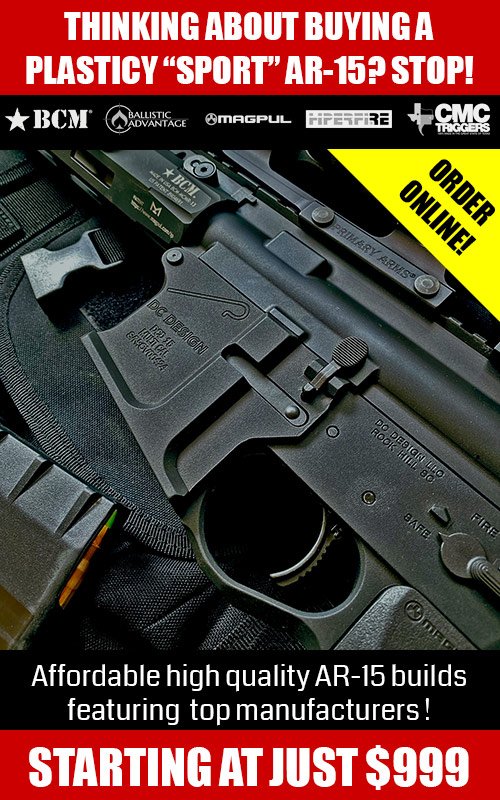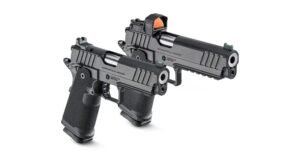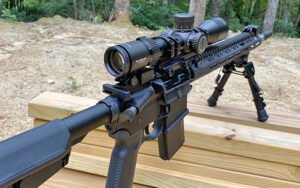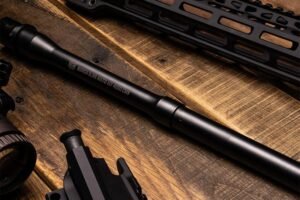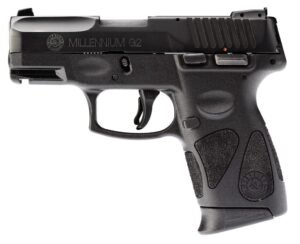AR-15 Pistol vs SBR. What’s the difference?
Note: The content contained in this article is for informational purposes only. It is not intended as legal advice and should not be taken as such. AR-15 Pistol vs SBR laws change and this content is not guaranteed to reflect those changes. Local jurisdictions may have additional ordinances and restrictions. Those wishing to obtain more information about the construction of an AR Pistol should alway contact the Bureau of Alcohol, Tobacco, Firearms and Explosives, and their local state government directly for the most up-to-date regulations.
To be clear, none of the firearms DC Tactical offers for sale through its website are considered NFA items. Our firearms are classified either as rifles or pistols under the legal definitions per the BATFE, and are transferred into your possession in the same way as any hunting rifle or handgun would be in accordance with your local laws. If you have any further questions or concerns, don’t hesitate to contact us.
“Is that a pistol or SBR?”
This is far and away the most frequent question we get regarding our products. Numerous times we’ve heard people say something to the effect of “I’d love to own one, but I can’t be bothered with the tax stamp”, while admiring what is actually classified as a pistol and requires no special ATF paperwork or fee.
The fact that there’s so much rampant confusion within in the firearms community around what does and doesn’t constitute NFA items, shows how poorly the laws are written. While some try to figure things out by researching and reading, the internet is full of outdated and just plain wrong information out there. Many folks finally get to a point that they decide just to steer clear of anything that isn’t a rifle altogether for fear of unwittingly getting themselves into trouble.
SBR vs Rifle vs Pistol Confusion
When it comes to the Bureau of Alcohol, Tobacco, Firearms and Explosives and its rules, things always make perfect sense, except when they don’t. Which is most of the time.
As you’ll see, laws around firearms classification can go from confusing to downright nonsensical. This is what happens when bureaucrats try to shoe-horn new technology and products into hopelessly outdated (and many would suggest unconstitutional) laws and regulations that were entirely ill-conceived or wrong-headed in the first place.

In this article, we’ll explain how arbitrary definitions applied firearms can affect how they’re treated in the eyes of the law, and clarify what you can do as an owner to make sure you stay on the right side of it. While this article may be AR-centric, the laws apply to all makes and models of firearms.
It all may seem crazy and complex, but trust us, when you get the end you’ll see it’s really a lot less complicated that it all seems!
BATFE Weapon Classifications
First it helps to understand the big picture as to what these classifications and definitions are. While you and I might think that the firearms world is made up of rifles and pistols, there’s actually a bit more than that to consider.
Basically the term “firearm” is the overarching definition the BATFE uses to describe a regulated weapon that either 1) fires a bullet or projectile via an explosive action, 2) is the frame or receiver of such a weapon, 3) a suppressor, or 4) a destructive device (explosives, etc).
The main thing we’re focused on here is part #1 of that definition. Under that main category, there are several sub-categories that classify most firearms into subcategories based on specific characteristics or features. For civilian purposes, rifles and pistols are the two most common subcategories, but several others can apply. If a weapon that shoots a bullet doesn’t fall within a special subcategory, it defaults back to simply being a “firearm”.
Rifles vs Pistols
Some assume the difference between a rifle and pistol is the length of the barrel. Those people are wrong. A rifle is defined in US Code 18 U.S.C., § 921(A)(7) as “a weapon designed or redesigned, made or remade, and intended to be fired from the shoulder.”
What makes a pistol a pistol? According to the BATFE, a “pistol” is defined in the US Code 18 U.S.C., § 921(A)(29) as “a weapon originally designed, made and intended to fire a projectile from one or more barrels when held in one hand and having (a) a chamber as an integral part of, or permanently aligned with, the bore; and (b) a short stock designed to be gripped by one hand and at an angle to and extending below the line of the bore”
So generally speaking, the main thing that differentiates a rifle from a pistol is whether it was either designed to be fired from the shoulder (rifle), or one-handed (pistol). And make a note here class, the term “designed to be fired” is key to this whole big conversion, which is NOT the same thing as how one actually uses the gun when firing.
In real life, the presence of a shoulder stock indicates a firearm is designed to be fired from the shoulder, and therefore falls into the rifle subcategory.

Still with us? Pretty straightforward, right? You wish.
NFA Weapons
To add a layer of complexity, some firearm configurations are subject to an additional layer of regulation called the National Firearms Act – you can read all about it here. Originally created in 1934, this act controls weapons and devices that for one reason or another are considered extra-scary.
It’s not that the public can’t own these super scary items, but doing so first requires applying to the government for a tax stamp. This means extra costs, more stringent background checks and increased processing times far beyond normal gun possession. It also restricts certain other things, like how these items can be transported, which can be of importance to owners as well.
There are two categories of NFA weapons we mainly need to be concerned with as civilian AR owners; short-barreled rifles (SBR) and Any Other Weapons (AOW).
The Short-Barreled Rifle (aka the SBR)
US Code 18 U.S.C., § 921(A)(8) details a short-barreled rifle as “a rifle having one or more barrels less than sixteen inches in length and any weapon made from a rifle (whether by alteration, modification, or otherwise) if such weapon, as modified, has an overall length of less than twenty-six inches.”
So the key takeaway here is that in order to be a SBR, the firearm has to be a rifle by definition (has a stock), with a barrel of less then 16 inches. This is why almost every AR-pattern rifle on the market is offered with 16″ or longer barrel. And to be clear, 16″ is referring to the fixed or static length of the barrel. That means things like muzzle devices are not taken into account unless they have been permanently attached to the barrel.
Side note: One can purchase a barrel (usually a 14.5 inch barrel) modified with the muzzle device permanently attached, or have it modified after the fact, but these can come with their own headaches. And when they say permanently attached, the BATFE doesn’t mean reinforced with duct-tape or loc-tite. In order to be considered as “permanently attached” a muzzle device would have to be attached to a barrel by means of welding, high-temperature (1100º F) silver soldering; or blind pinning.
The 26″ inch overall length part isn’t really a concern most of the time – any standard Mil-Spec AR rifle with a 16″ or longer barrel will be more than 26″ in overall length.
Just to be clear, if you buy an AR rifle from a retail store, you’ll be fine. They’re (hopefully) not going to let you walk out with something you shouldn’t, lest they be in a lot of trouble.
The problem generally happens when new builders or DIYers are naïve to the law. Barrels shorter than 16″ are easily purchased. These unwitting folks then swap that shorter barrel onto their existing rifle, not realizing they’ve just made a SBR – a regulated NFA weapon. Per the BATFE: “Creating (a SBR) without first completing the proper NFA forms, paying the required $200.00 tax and receiving approval from the ATF NFA Branch is unlawful and would subject the violator to arrest and prosecution.”
Cue the ominous music.
Blurring the Lines: SBRs vs AR Pistols
Of course, you can certainly own an AR that has a barrel shorter than 16″ without all the cost and paperwork. It’s just that care and consideration must be taken to understand the legal technicalities in order to avoid the consequences of creating an SBR as per the BATFE description.
So how do we do that? Well, it’s ridiculously simple. Slide an AR rifle’s stock off the buffer tube, and it’s no longer a rifle in the eyes of the BATFE. As per the BATFE legalese, the standard configuration of an AR-15, minus the stock, is no longer designed to be fired from the shoulder, and therefore not a rifle.
And to take that logic one step further, you obviously can’t have a short barreled rifle if you don’t have a rifle in the first place.
So if it’s not a rifle, what is it? Well if you laid a stockless 16-inch barrelled AR next to a Glock 19 and told people they were both pistols, they might look at you funny, but you wouldn’t be lying. The BATFE considers them the same thing from a classification standpoint. And as a pistol, a firearm is not subject to the same barrel length restrictions as a rifle. Companies and individuals began building their ARs without stocks, and as such were free to put shorter barrels on them. The AR Pistol was born!
Bring on the Braces
Okay, so basically your barrel can be as short as you like, as long as your AR isn’t outfitted with a stock. That’s not that hard. Why all the confusion?
There’s a bit of blame to go around.
For a while, AR pistols did (and still do) simply have bare buffer tubes, sometimes covered by a piece of tubular foam. They were easy to recognize as pistols. People had their mini-ARs, but all was not well.
The thing is, rifle calibers are designed to be fired from rifles for good reason – the shoulder stock makes it much easier to steady the weapon and shoot accurately. Owners quickly found that despite what the movies showed, firing these comparatively powerful cartridges accurately without the benefit of shouldering the weapon wasn’t that practical or enjoyable. Because of this, AR pistols were mainly regarded as tacti-cool range toys, but lacked any real-world benefit.
A New Hope
But that began to change about a decade ago.
Sensing a need for something better, a few companies began developing products that could be attached to the buffer tube of an AR pistol to aid with shooting one-handed, yet didn’t qualify as a stock. They called them “braces” or “stabilizers”.
While they were originally developed for disabled shooters, the mainstream caught on and they grew in popularity. Using straps, the shooter would secure the brace to their forearm, which had the effect of stabilizing the AR pistol as it fired. This mitigated recoil and made follow-up shots easier.

This suddenly made the AR pistol a bit more comfortable and controllable. Long story short, the ATF was okay with this and all was well. SIG Sauer, in collaboration with SB Tactical, was one of the first to widely market one of these so-called braces, called the SB15. And they sold a ton of them.
Of course as braces became more and more popular, more owners started looking at them and understandably began to think, “It kinda looks like a stock and it seems solid enough work like a stock. Gosh-darnit, why don’t I just put it up to my shoulder like a stock when I shoot?”
And they did. It wasn’t quite as effective as an actual stock, but it was a lot nicer to shoot that way than having it tied to your arm. What little it gave up in comfort was certainly tolerable when weighed against the cost and hassle of the tax stamp process for an actual stock. Other companies joined in the fun and braces grew and grew in popularity as way to get the benefits of a SBR without the tax stamp. Pictures were posted, videos were uploaded, shooters rejoiced.
Everybody loved this…except the ATF.
The Empire Strikes Back
In 2014, the kibosh came down. The ATF saw how braces were basically being used as stocks, effectively skirting NFA regulations. They issued a decree that basically stated that if you put a brace-equipped pistol up to your shoulder and fired it like a rifle, you had effectively “redesigned” it to shoot from the shoulder. And as we covered before, if it’s designed to be fired from the shoulder, that makes it a rifle by definition.
Since these now “rifles” had barrels shorter than 16″, that meant these gun owners were supposedly in possession of SBRs each time they shouldered their pistols. Of course these owners did not have tax stamps for these SBRs, so they worried they could suddenly find themselves illegally in possession of NFA weapons, a charge which potentially carries dire legal consequences including large fines and significant jail time.
This lead to a mass ditching of braces, as owners did not want to take the chance of running afoul of the law. Sales dropped. AR pistols again became somewhat passe.
Return of the Brace
Regardless of the alleged intentions of shooters to circumvent NFA regulations, the logic behind the BATFE’s 2014 decree was viewed as fairly ridiculous by pretty much everyone. Fire from the hip or with one hand, it’s a pistol, but if you raise it to your shoulder, you’ve somehow “redesigned” it? How can it be a rifle one second then a pistol again the next? Clearly that doesn’t make a ton of sense.
Regardless of how silly it all was, the BATFE maintained their position for nearly four years, but after a concerted effort by gun owners and manufacturer lobbying, the BATFE walked-back their stance in early 2018 by (rightly) stating that it was the original design purpose that mattered. So long as a brace isn’t modified in any way, a brace-equipped pistol would not magically become a rifle simply by the act of firing it while shouldered.
Once again we were back to “not a rifle, therefore not a SBR”. AR pistol owners are more or less happy, and braces, like the ones available on the AR pistols we sell, are back in fashion and continue to be improved in an effort to make them as close to stocks as possible without being designated a stock, especially as pistol caliber ARs become more and more popular.
And that’s where things remain today despite threats from the current administration to revisit.
In light of all this, one has to ask what purpose is served by having SBRs on the NFA list at all. Presumably someone felt that a compact, rifle-powered firearm was a danger to the public, but clearly many thousands of AR pistols are out there firing the same caliber as their rifle counterparts. The world goes on.
End of story? Not quite.
Any Other Weapon (AOW)
In addition to ensuring you don’t inadvertently create a SBR, there’s another classification of NFA weapon you need to be cognizant of called the “Any Other Weapon” (AOW) .
If you remember, technically a pistol must be designed to be shot one-handed only, “designed” being the key word here. If you outfit a pistol with a vertical foregrip, it would change its one-handed “design” to a two-handed design, making no longer a pistol at all, but an ‘Any Other Weapon” according to the BATFE. AOWs do require a tax stamp, just like a SBR.
Here’s where it gets silly. If it’s designed to get your thumb around, it’s considered a second grip and therefore meant for two-handed operation. But an angled foregrip – which also provides a place for your off hand go to stabilize the weapon, just at…you know…an angle, well that is all fine. I wish we were joking.
However, there is a caveat that a lot of folks aren’t aware of. Another determining factor of what makes a firearm an AOW is the ability to be concealed. According to the BATFE, 26 inches in overall length is the arbitrary size that makes a firearm concealable or not.
If you’ve ever tried to stuff a 25.9 inch AR down your pants, you’d probably agree that they’re pretty far from concealable, but we digress.

So if your pistol has a permanent length of 26 inches or more, you can put a vertical grip on it. And guess what? That changes its classification yet again. What you now have lacks the defining characteristics of a pistol, rifle, SBR or an AOW, and as such reverts back to the basic category of just “Firearm”. But we still refer them to as pistols for sanity sake. The important part is that a 26 inch “Firearm” isn’t a NFA weapon.
In our experience, an AR-15 pistol outfitted with a barrel 11.5″ or longer is likely at least 26″ overall in its shortest permanent configuration, though obviously each owner should measure their own pistol and consult with the BATFE to ensure compliance. Shortest permanent configuration means with the brace removed, and not including a muzzle device unless its permanently attached. In other words, in most cases we’re talking about measuring from the end of the barrel threading to the end of the buffer tube.

Identity-Confused Rifles
This is where things really start to jump the shark.
You’re confident you now know the rules. You’re looking at that AR rifle you bought a few years back from your local gun store and thinking, “Gee, I think it would be fun to put a pistol upper on that instead.”
Don’t.
The law states that a firearm that’s been legally sold or transferred into someone’s possession as a rifle at any point in it’s life can’t be converted into a pistol without officially re-registering it as a pistol with the government – a process that’s just as annoying, expensive and time-consuming as applying for a NFA weapon tax stamp.
Just to be clear, we’re talking about an official FFL transfer where the transferee completes form 4473 (Firearms Transaction Record) and the dealer includes the details of the firearm – the brand, serial number, type, etc. If a firearm has at any point been classified on that form as a rifle, it must stay a rifle. Conversion to pistol is a no-go. If you were caught with it and the ATF traced the serial number back to the purchase that classified it as a rifle, you’d be in illegal possession of an unregistered pistol.
If you originally bought the AR as a pistol, you can change it however you like.
On the surface this makes a little bit of sense (only a little), since in many states the background check requirements for taking possession of a rifle are less stringent than a pistol.
What about a standalone receiver, or even an assembled lower without an attached upper? Usually they’re transferred to the buyer as “Other” on form 4473 since it’s technically neither a pistol or rifle at that point. If that’s the case, you can build whatever you want with those, but you’d want to ask at the time of transfer, just to be sure because there are always exceptions. For instance, if an assembled lower is sold with a stock installed, it likely has been transferred as a rifle.
Summing It All Up
After all that, we would’t blame you for wanting to avoid AR pistol ownership altogether. The thought of wading through all the legalese to make sure that your firearm complies with the law can be overwhelming.
The funny thing is, everything you’ve just read can be boiled down to a few pretty simple rules-of-thumb. By sticking to these, an AR owner can steer clear of the SBR/AOW trap.
- If the fixed length of your barrel is less than 16″ you can’t put a stock on your firearm. You must use a brace or bare buffer tube.
- As per current BATFE decree, your brace-equipped pistol can be shouldered, so long as the brace is not modified from its original configuration.
- If the overall permanent length of your pistol is less than 26 inches, you can’t attach a vertical foregrip, but an angled foregrip is allowed.
- If a firearm was at any time documented in ATF form 4473 as a rifle, you can’t convert it to a pistol.
Good luck with your AR journey, wherever you may be on it. If you have any questions, please don’t hesitate to reach out!
Springfield Armory Prodigy Review
The Springfield Armory Prodigy takes the proven 1911 platform and enhances it with double-stack capacity and a performance-driven feature set.
What is a RECCE Rifle? Meet the Longshot
US Navy Seals developed today’s Recce Rifle concept in the early 90s to bridge the tactical gap between their CQB M4s, and their larger and heavier precision rifles.
Smith & Wesson CSX Review
Smith & Wesson’s CSX joins the market of similar high capacity micro 9s while standing out from the crowd with features and flourishes not found on many competitors.
5.56 NATO VS .223 WYLDE
People new to the AR-15 can be forgiven for believing that they’re only made to fire the 5.56 NATO cartridge – the same that militaries around the world use (the NATO designation is there for a reason). They’ve also likely heard that for all intents and purposes, the 5.56 NATO and .223 Remington cartridges are pretty much…
Taurus G2C Review: Amazing Value or Too Good to be True?
Taurus G2C Review The Taurus PT-111 G2 has undergone a few minimal internal improvements and cosmetic changes and released back into the wild as the Taurus G2C. With many retailers offering this subcompact for around the $200 mark, it’s certainly turning a lot of heads and getting a lot of interest. Of course, one of the…

